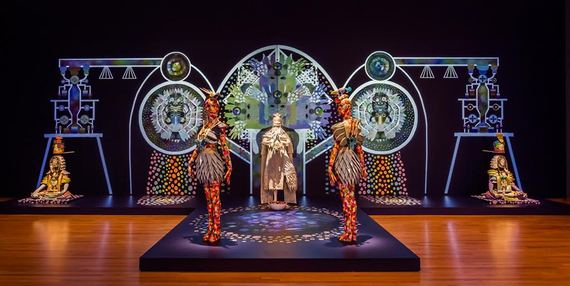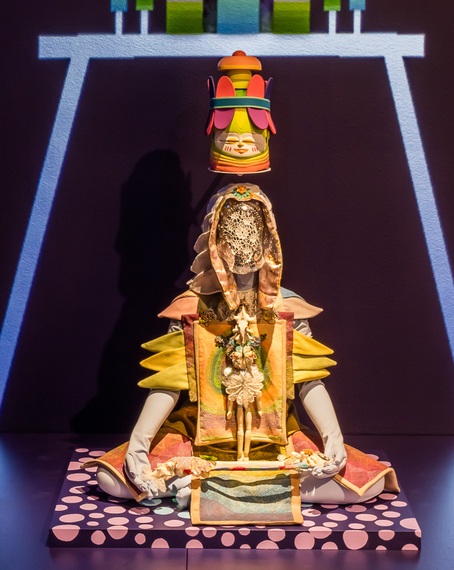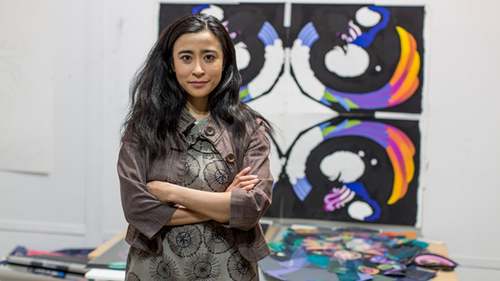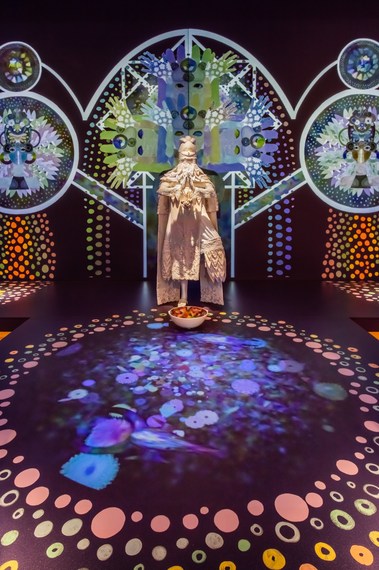Here is the simple truth: We live in a multicultural world that is built on a history of division and prejudice.
We take comfort in the boxes that we check on our Census form, and simplify our identities so that they may be easily understood by others. In reality, we are more than just black, white, Latino, Native American, or Asian. We are multidimensional beings, heavily influenced by living among a variety of cultures. Our bloodlines are not unilateral.
Our experiences, however, are greatly determined by our racial identity. Legacies of European colonialism and slavery have deeply affected the sociopolitical mobility of communities of color. Without empathy and equity to resolve racial tensions, we remain divided.
Although our cultural consciousness surrounding race hasn't advanced to the point of resolution, we are becoming increasingly blended.
Artist Saya Woolfalk is disrupting cultural boundaries by creating worlds that push museum goers to question who they are and how they navigate through a multicultural world. The installation ChimaTEK: Virtual Chimeric Space features the "Empathics," women whose absorption of culture results in a genetic transformation into a hybrid being--part human, part plant. They are porous, and ultimately demonstrate acceptance and a need to evolve.
Deemed "Afro-futurism," Woolfalk's use of science fiction, anthropology, mythological research, and her own experience points to her elevated understanding of what it means to be a global citizen. She utilizes sculpture, paintings, digital video, ethereal music, and performance art to design a world and experience for that global citizen.
Woolfalk has shared with me her journey, intentions, and vision for creating a physical space for self-reflection and cultural critique.
How does your work question cultural boundaries?
Initially my work was supposed to explore the independent modes of representation within each of the different cultures. But, as I've been developing the work from No Place to the "Empathics," and then ChimaTEK, I started exploring what it means when cultures come into contact with one another, how they impact each other, and ultimately, how they shift and transform one another. It's not just about individuals, and how each person moves through space. It's about how we view cultures as discrete units that are separable and can become completely disaggregated from each other.
Although cultures do have important political utility, the idea that cultures develop in vacuums is false. Cultures really build on each other. American culture is a serious hybrid--an agglomeration of all of the different immigrant groups and nationalities. It's history of European colonialism, slavery, and Native American history made our culture what it is today. The "Empathics" is an exploration of that.
The "Empathics" use both scientific methods and spirituality to transform into hybrid beings. Yet, science and spirituality are commonly thought of as opposing practices. What was your intent in blending them?
I started working on No Place when I was studying performance tradition in northeastern Brazil. While I was studying, my husband, who is an anthropologist, was researching the ways that descendants of escaped slave communities understand and mobilize political identity and "blackness." He, as a social scientist, and I, as an artist, were exploring this place together. I became very interested in his scientific research method, but I was working with performance practitioners whose performances were deeply tied to their spiritual practice.
When I came back to the states, I wanted the project to blend science and spirituality. I was thinking about the difficulties of notating the world through scientific means, and combining that with the hopeful imaginary of spirituality. When I think about it, a lot of Western European knowledge production comes out of Christianity. Science and religion have always been intertwined, but have somehow come distinct entities within American culture.
Science can't necessarily get to everything that humans experience and feel. When science and spirituality are allowed to complement each other, people may feel a bit uncomfortable, but together they allow a more complex understanding of our world.
What elements do you use to encourage museum goers to reflect on their own cultural consciousness?
I use color, sound, and objects that are both familiar and unfamiliar. It eases people into a place that may be uncomfortable, but valuable in the multicultural world that we live in. The total experience offers an opportunity for self-reflection into who we are and how we navigate through the world.
How has your experience as Japanese, African-American, and white shaped the worlds that you create now?
Ever since I was a kid, I shifted cultures constantly. Now, I identify as American, but I grew up binational, going between the United States and Japan.
I was born in Japan, and I would go there every summer. I think a lot about how that experience caused me to shift my own conception of myself and my body, in order to function in the Japanese culture. Then I would come back to the United States, and I'd have to shift again. The crossing of cultures from a young age had a large impact on how I came to know myself as a human being.
My father is African-American and white, and when I was with his family, I code switched a lot. I spent a lot of time moving through spaces with different cultures in the US. Each time I moved into a new space I'd have to become a different component of myself. This process made me who I am today.
I encountered ChimaTEK as part of the Disguise: Masks and Global African Art exhibit, yet it has also been featured as a part of Enter the Mandala: Cosmic Centers and Mental Maps of Himalayan Buddhism at the Asian Art Museum. What does it mean to have different communities display your art?
I've identified my whole life as a "culture-crosser" and I very much want more people to experience that as a reality for themselves. The response that I've received from multiple communities has been a dream come true for me.
What do you hope people will take away from your work?
My work has been about trying to blur things, make things hybrids, make things a little less clear. By creating a space of discomfort and ambiguity, participants can come to a more complex clarity about who we are and how we move in the world.
I want people to experience something that simultaneously makes them slightly uncomfortable about the potential of the world that I have created, but also gives them an excitement about a harmonious, multicultural society.
Disguise: Masks and Global African Art, which features ChimaTEK: Virtual Chimeric Space, is at The Brooklyn Museum through September 18, 2016





